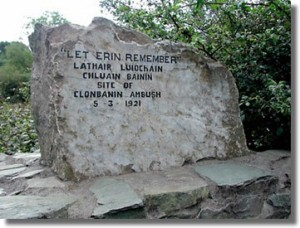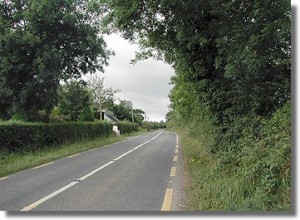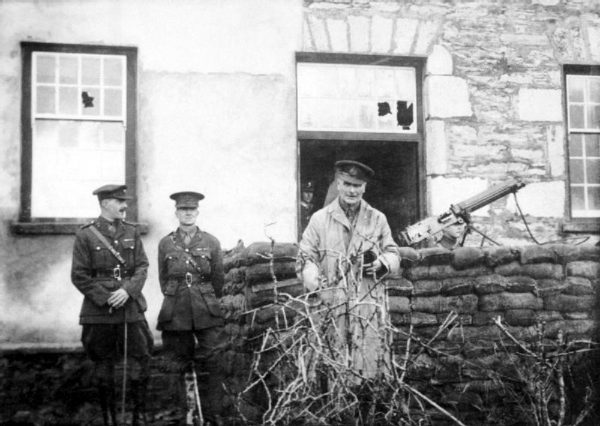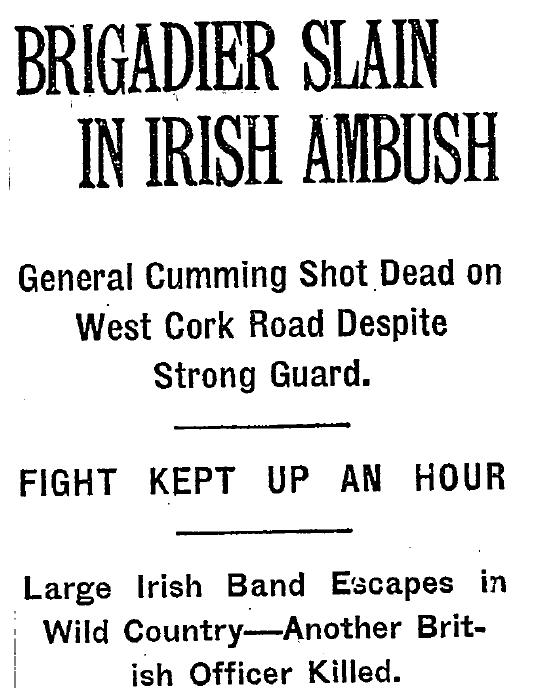
On this day March 5th 1921, the IRA ambushed a British army convoy near Clonbanin, near Derinagree, killing Brigadier General H. R. Cumming, one of the highest ranked British officers to die in the Irish War of Independence. After two hours fighting, 13 (apparently) British were dead, and 15 wounded, while the republicans suffered no casualties.
—-
In early March, 1921 Sean Moylan, Commandant of the Newmarket Column, made the decision to ambush a British party of senior officers and their military guard returning from an inspection tour in Kerry. The position he selected was at Clonbanin, near Derinagree, which was about five miles from Kanturk, where there was a strong military post and five miles north of Millstreet, then garrisoned by a force of Black and Tans and RIC.
At 3 a.m. on the morning of the 3rd. March, Moylan’s column moved out for Clonbanin and was in position by 6 a.m. They were joined by a section of the Kerry No. 2 Brigade Column, under Commandant Tom McEllistrim, and a detachment from Charleville Battalion Column, under Commandant Paddy O’Brien. The Newmarket and Charleville units occupied positions on the northern side of the road. The Kerry men and a section of the Millstreet Column had positions on the south side of the road. They had one of the Hotchkiss guns captured at Mallow, manned by Bill Moylan and Denis Galvin. The remainder of the Millstreet Column occupied a position covering the roads from Kanturk to deal with expected reinforcements from that direction. The local companies provided scouting and protective elements.
 Commandant Paddy O’Brien detailed the sections to their positions and Commandant Moylan arranged for the laying of the half dozen road mines which the force had. And at 7 a.m. the column was ready for action. Strict instructions had been given to the section commanders that fire was not to be opened on any target until a mine was exploded, the explosion being the signal for attack. This was necessary because of a decision come to by Commandants Moylan and O’Brien that a very small British force passing through the position would not be attacked, as long as the hope of intercepting a larger target existed.
Commandant Paddy O’Brien detailed the sections to their positions and Commandant Moylan arranged for the laying of the half dozen road mines which the force had. And at 7 a.m. the column was ready for action. Strict instructions had been given to the section commanders that fire was not to be opened on any target until a mine was exploded, the explosion being the signal for attack. This was necessary because of a decision come to by Commandants Moylan and O’Brien that a very small British force passing through the position would not be attacked, as long as the hope of intercepting a larger target existed.
At 10 a.m. the outposts signalled three lorries coming from the east. This was unexpected, but Moylan and O’Brien decided to attack. As the leading lorry drove over the mine controlled by Moylan he pressed the switch but there was no explosion. At the same moment O’Brien, covering the driver, pressed the trigger of his rifle. The round failed to go off. Incredibly, the three lorries passed through the ambush position, a soldier in one of them playing an accordion, the others singing, blissfully unaware of how close they had been from disaster. It later transpired that the reason for the mine failure was that high tension wires were being used with a low tension battery.
However, it was still early in the day and the expected convoy from the west would surely make an appearance. The men settled down again for a long wait. At 2.15 p.m. the patience of the waiting column was rewarded; a convoy was signalled coming from the west. It consisted of three lorries, an armoured car and a touring car. The vehicles were spaced, as had been anticipated, at such intervals as to cover half a mile of road. No attempt was made now to use the mines. Fire was opened on the leading lorry, the driver was hit and it was ditched. A burst from the Hotchkiss penetrated the slit in front of the driver of the armoured car; the driver was wounded and it too was ditched. The remaining vehicles halted, their occupants dismounting rapidly and seeking whatever cover was available. A tall man in officer’s uniform was seen to jump from the touring car and run for cover on the north side of the road. He was shot down before reaching there and was later discovered to be Brigadier-General Cumming.
The action intensified and developed into a long duel that did not end until dusk. Shortly after the armoured car was ditched its heavy machine-gun came into action and continued firing during the entire course of the fight. The opposing forces were about equal in strength but the British had the advantage of heavier weapons and a far better supply of ammunition. The armoured car commanded the road and prevented two efforts made by the IRA to drive in the flanks of the British position. The British forces, too, attempted an outflanking manoeuvre but it was defeated by IRA. fire. The British had the advantage also of a deep ditch and several houses which gave them cover from the fire of the Kerry and Millstreet units on the south side of the road.

The I.R.A. had no means of putting the armoured car out of action and they always had to consider the possibility of reinforcements reaching the British. The sound of firing could be heard distinctly at Kanturk, Newmarket and Millstreet, and reinforcements from these posts would eventually arrive. General Cumming’s brigade headquarters at Buttevant was only twenty-five miles away, and the fight had continued for well over two hours. As dusk drew in it was decided to withdraw, the Kerry and Millstreet units to the west, and the Newmarket and Charleville units north to Kiskeam. It was learned later that the British casualties were thirteen killed and fifteen wounded. The columns suffered no casualties.
This article originates from Cork’s War of Independence
The incident was reported on the front page of the New York Times (March 7th 1921)
BRIGADIER SLAIN IN IRISH AMBUSH
General Cumming Shot Dead on West Cork Road Despite Strong Guard.
FIGHT KEPT UP AN HOUR
Large Irish Band Eacapes in Wild Country—Another British Officer Killed.
DUBLIN, March 6.–Brig. Gen. H. R. Cumming, D. S. 0., was killed in an ambush In West Cork yesterday afternoon. He was in control of a Kerry brigade and was returning heavily escorted from Killarney to his headquarters at Buttevant. General Cumming had just crossed the border from Kerry into Cork when the attack developed. The touring car in which he travelled with his aide de camp was preceded by three tenders filled with troops of the East Lancashire Regiment and an armoured car protected the rear. At the point where the ambush took place- the country is bleak and mountainous and the rebels were well concealed among the gorse covering the slopes on both sides of the road. They had laid their plans carefully. Road mines had been prepared but proved defective and did not explode. The fact that the chauffeur of the leading tender was badly wounded complicated the position for the troops, of whom there were less than forty altogether, while the attackers outnumbered them and were largely armed with service rifles.
The tender ran into the ditch, and the armoured car in endeavouring to pass it and come into action suffered a similar fate under a hail of bullets poured on them from the high ground by their opponents, who were so cunningly under cover that they were seldom seen during the whole of the hour’s skirmish. The troops dismounted and replied as best they could.
General Cumming was hit in the head shortly after leaving his car and died immediately. One party from the head of the convoy gradually worked round to the rear of the rebels on the south side of the road, but before they could open an effective fire the attackers became aware of their precarious situation and dispersed. The body holding the north side of the road also retired when their flanks became endangered from another laborious enveloping movement by the troops and the engagement ended in an intermittent exchange of shots.
The military casualties were two officers killed :and two of other ranks wounded. The scene of the ambush is variously stated as Clonbanin and Clonbanin, the latter being near Cullen, which is north of Millstreet and about nine miles from Kanturk. Crown forces made exhaustive search of the neighbourhood afterwards, but with what result is unknown, nor is it ascertained whether the Republicans met with any casualties. General Strickland had been on a tour of inspection in this area during the week, and in some quarters It is believed the ambush was prepared in expectation that he would pass that way. The entire district is a notorious operating ground for rebels, and General Cumming in dealing with the section had the hardest task of any of the subordinate commanders in Ireland. One of his last important duties was to preside at the semi-public inquiry into the Mallow shootings, which were the cause of the recent threatened railway strike in Ireland.
The ambushers were in possession of at least one machine gun and a big stock of hand grenades.
====
BELFAST, March 6.—Brig. Gen. Cumming, who was killed at Clonbain on Saturday when a military convoy was ambushed, had his headquarters In the barracks at Buttevant, some miles to the northeast of the scene of the ambush. Recently General Cumming had motored each morning to Mallow, where he presided over the court of inquiry into the murder there recently of Mrs. King, wife of County Inspector King, and the shooting of railway men after the Murder.
Extraordinary precautions were taken on these trips. Parties of soldiers motored in advance. General Cumming following in his own car with two soldiers sitting behind him. An armoured car with machine guns ready brought up the rear. Outside the court house during the preceding of the court, at the hotel where the General ate lunch and in the streets traversed by him between the court house and the hotel, large detachments stood guard. Two previous attempts had been made to ambush General Cumming.

Further Reading:
To read more on the background of Brigadier General Cumming who was killed, see his file on the Cairo Gang
The Wild Geese: The Clonbanin Ambush: “To Hell With Surrender!” (Very detailed article) TODO: study this properly.
Those Killed:
Brigadier General Hanway Robert Warren Cumming (56 yrs old, married) Commander of the Kerry Infantry Brigade [death]
Lt. Harold Adolphe de Maligny (33 yrs old, married) Army Officer [death]
Harold Turner (23 yrs old, single) Soldier [death]
William Walker (17 yrs old, single) Soldier [death]
… who were the rest of the 13 mentioned as killed. The death registrations only list the four:



The death toll reported at Clonbannin ambush seems exaggerated, the Cairo gang website section British soldiers killed in Ireland reports General Cumming, a lieutenant and two soldiers all named with their biographies. I have found that site the most comprehensive and accurate.
There are 12 BMH witness statements that mention Clonbannin but none clearly claims 13 deaths.
is there anyway of getting the names of all the ira members that participated in the clonbanin ambush my father may been involved